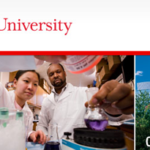By Nick Chiles
The Hechinger Report, May 24, 2017 —
All institutions could be taking these steps to improve the success of non-white students
As high school seniors preoccupy themselves with college decisions, graduation parties and summer jobs, some may be grappling with a nagging thought in the back of their minds: Am I smart enough to succeed at the University of X?
That question may be even more acute for black and Latino students, whose track record of success is decidedly mixed at many institutions — particularly in areas like math and science. In addition, blacks and Latinos have been getting further behind whites and Asian-Americans when it comes to earning bachelor’s degrees, a recent report found.
But perhaps students should be asking the inverse question: Is the University of X good enough for me?
With declining enrollments and the nation’s desperate need for more skilled workers, colleges should be making sure they are as welcoming and supportive as possible to all students, including blacks and Latinos, according to nearly a dozen experts interviewed by The Hechinger Report.

Parent Toolkit, The Hechinger Report
The scholars do, however, suggest potential solutions to make higher education far more inclusive.
Here are five steps every college in the country should be taking to help every student succeed:
1. View student failure as a problem with the institution, not the student.
Charles Fisher, professor of biology and associate dean for graduate education at Penn State University, says professors in STEM classes traditionally view themselves as gatekeepers, choosing the elite students who deserve to be scientists, engineers or doctors — and discarding everybody else.
“But Penn State and other schools are diligently changing that,” says Fisher, who also directs the Millennium Scholars Program, aimed at bringing more black and Latino students into the sciences. “Now we tell faculty, ‘When you look out at your classroom of students, you should see 100 students carefully selected to succeed at this university. If those 100 students don’t succeed, you’re failing them. What are you doing wrong that those students can’t learn the material you’re here to teach?’ There is a national effort at any university worth its salt to change that paradigm, to get rid of those dinosaurs from those introductory classes — or reeducate them.”
2. Encourage students to study together and to support each other.
More than 40 years ago, almost by accident, Uri Treisman became a pioneer in leading black and Latino students to academic success in math and science with a program he started at the University of California-Berkeley. While a graduate student working on his dissertation in mathematics in 1974, Treisman investigated why so many black undergraduates were failing calculus while Chinese students were thriving — even though the black students were working just as hard or harder.
After months of research, Treisman and his team found the answer: The Chinese students were working together in groups, in which they could help and bolster each other, while the black students were all working in isolation. Treisman got permission from Berkeley to create what would eventually become the Emerging Scholars program, structuring it so that black and Latino students would learn to work together in groups.
The results were dramatic: The black and Latino students began to outperform the white and Asian students in their classes. Many of the black and Latino students went on to earn Ph.D.s and become distinguished scientists, engineers and physicians.
Over the next four decades, Treisman’s group model became one of the fundamentals for leading black and Latino students to higher education success in STEM. In 1992, Treisman received one of the MacArthur Foundation’s “genius” grants, recognizing his transformational work; in 1999, Black Issues in Higher Education magazine named him one of the 20th century’s outstanding leaders in higher education.
Treisman had his students not only study together but sit together in the front of their classrooms and ask plenty of questions so that their performance would be noticed by startled professors not used to such behavior from black and Latino students. The students became transformed when they realized they could perform just as well as the Asian students — a finding Treisman says is consistent with research done by social psychologist Claude Steele.
In numerous studies detailed in his book “Whistling Vivaldi: How Stereotypes Affect Us and What We Can Do,” Steele showed that when individuals are confronted with a test or situation in which they are in danger of confirming a stereotype about their group, their performance plummets. He called this phenomenon the “stereotype threat.”
Steele’s research has enormous implications for black students at predominantly white schools, where on an almost daily basis they are in situations in which they must confront the historical stereotype of blacks as less intelligent. Among the ways that this stereotype threat can be reduced, according to Steele, is for black students to socialize and have personal discussions with students from other racial groups so they begin to see that these students are dealing with many of the same challenges on campus.
Treisman is now a professor of mathematics and of public affairs at The University of Texas at Austin and founder and executive director of the University’s Charles A. Dana Center, which works with institutions across the country to create successful environments for students of color. He says universities can no longer get away with isolated programs to deal with the issue of racial achievement gaps; reforms must be campus-wide and embraced by all faculty members in order for black and Latino students to truly thrive. Schools must also move away from forcing students of color into remedial programs.
“Those students need to learn how to navigate the boundaries of the different social worlds that make up higher education,” says Treisman, who used his experiences at Berkeley to create the Dana Center. “They have to learn how to try on the identities of the professions, to feel that they own them and have the right to play with them. This is in opposition to remedial programs, which lead people to think of themselves as outsiders. With remedial programs, they learn math as a compliance activity.”
Based largely on the success he has had with students on his campus, Freeman Hrabowski, the president of the University of Maryland-Baltimore County (UMBC) and one of the nation’s foremost experts on the education of black and Latino students, says that achieving such change takes total campus involvement, not just an isolated diversity office.
“You’re not going to show tremendous difference in performance if you don’t have the most powerful people on the campus involved in the work,” Hrabowski says. “Diversity offices are very nice and can be supportive, but the power of the academy is in the hands of faculty, the professoriate. It’s only when there is a cultural difference, focusing on everybody from faculty, staff to administration, saying the success of these students from different backgrounds is a top priority on campus, only then can you make a difference.”
4. Change the mindset of faculty so that they have high expectations of success for black and Latino students.
Twenty-nine years ago, Hrabowski — an African-American mathematician — established the Meyerhoff Scholars Program at UMBC with the financial assistance of philanthropist Robert Meyerhoff. The program relies heavily on the group approach, keeping several dozen high-achieving students — mostly black and Latino — together throughout their undergraduate years so that they can become a strong social and academic support network for each other.
And though there are only about 50 undergraduates selected for the Meyerhoff program each year, it has managed to transform the UMBC campus. Michael Summers, a professor of biochemistry at UMBC who is connected to the Meyerhoff program, says he is astounded that a program with only 200 students has been able to change the culture of a campus of 11,000 undergraduates.
“What happened at UMBC is that faculty expectations changed — and not only faculty but the expectations of white students and even minority students who aren’t in our program,” Summers said. “Freeman has students show up to big lecture halls 15 minutes ahead of time, sit together as a group in the front row, and boldly ask questions. They go to the tutorial center not to pass a class but to make A’s — and they end up being tutors. … If you’re a white faculty member delivering a lecture to a class of 300 chemistry students and you have 30 minority students sitting together in the front row every day, arriving before you get there, asking tough questions in class, showing up to office hours and typically one of them will earn the top grade on the exam, it changes what that faculty member expects from all students of color.”
Professors have had to adjust as a result, Summers said. “And then what happens — and I’ve heard this from colleagues in senior-level classes — whereas the professor used to be accustomed to seeing a black student sitting in the back of the upper-level courses and earning a C, now if a black student earns a C they will be called into the professor’s office because the professor will want to know what the issue is. When you start seeing this, which is what happened to me, and it’s right in your face, it forces you to look in the mirror and ask, ‘What have I been thinking all these years?’ ”
Of UMBC’s 11,000 undergraduates, about 17 percent are black and 7 percent Latino. Whites make up 43 percent of the student population while 21 percent are Asian.
Between 2005 and 2014, only five universities in the country had more black undergraduates go on to earn doctorates in science and engineering than UMBC, which had 93, according to statistics from the National Science Foundation. Of the top 10 schools on that list, UMBC was the only school that wasn’t an HBCU (historically black college or university).
According to the Association of American Medical Colleges, UMBC also had more black undergraduates go on to complete M.D./Ph.D. programs than any other school in the country between 2011 and 2015 — UMBC had 15, while Yale, which was second, had seven.
5. Form a robust, aggressive corps of counselors for students, particularly students of color.
Marlisa Shaw, a black freshman at Penn State, credits the counselors in her school’s Millennium Scholars program with making it much easier for her to excel in the classroom.
“The support system is unbelievable,” says Shaw, 18. “I can come in and talk to my counselor about anything. I honestly believe in order to do well in academics you have to be supported in your personal life as well. A lot of times that can affect how you’re doing in school.”
Georgia State University has used its counseling services, called “GPS Advising,” to transform the performance of black students on its midtown Atlanta campus. GSU closely monitors student performance and, using computer algorithms, sends an alert to counselors when a student’s performance veers off course just a bit. Counselors then reach out to students to see what’s wrong.
Using the advising system and numerous other student supports, Georgia State now graduates more black students with bachelor’s degrees every year than any other nonprofit school in the United States (1,777 in 2015).
If more schools move toward implementing these measures on campuses across the country, experts say the performance of black and Latino students will make a dramatic leap forward.










